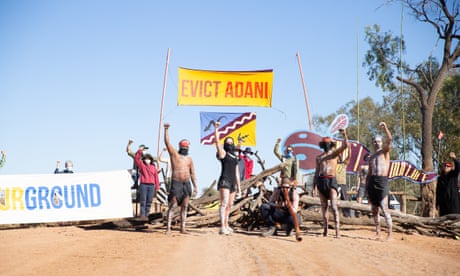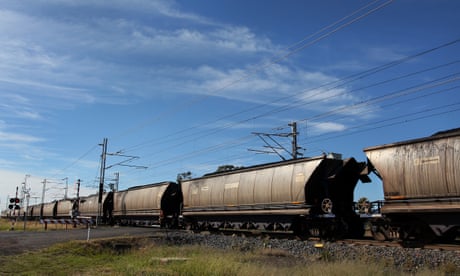Extract from The Guardian
Hydrogeologist says groundwater changes may have already caused irreversible damage to nearby Doongmabulla Springs.

The Doongmabulla Springs near Adani’s Carmichael coalmine site with dust visible from land clearing operations. The springs are a sacred site for Wangan and Jagalingou people.
Last modified on Thu 8 Jul 2021 03.32 AEST
Aquifer levels have dropped “significantly” near the Adani Carmichael coalmine since 2019, prompting concern from groundwater experts that the large volumes of water being pumped may have already “locked in” irreversible damage to sensitive wetlands.
Groundwater monitoring data from one aquifer in the south-west corner of the mining lease shows a drawdown of about 50 metres in the past two years.
As Adani prepares to begin extracting coal from the Carmichael mine in Queensland, water issues loom as last-ditch hurdles.
Guardian Australia revealed last month the company had obscured details about its plans to source large volumes of water, after approval for a large-scale water scheme was overturned. The company later claimed its water sources were “commercial in confidence”.

Now a group of Wangan and Jagalingou traditional owners say they are considering legal action to stop ongoing groundwater extraction from coal seams at the Carmichael site.
The group, the W&J Nagana Yarrbayn Cultural Custodians, sent a detailed legal brief to the Queensland government in April, citing concerns about risks to the sacred Doongmabulla Springs.
The brief included a report by RMIT University hydrogeologist Matthew Currell, which concluded that baseline groundwater data compiled by Adani was not adequate to protect the springs, or fully comply with the mine’s approval conditions.
The Queensland Department of Environment and Science investigated the complaint but took no action. The department claimed Adani’s baseline monitoring “met the intent” of its conditions.
Springs at risk
Currell said groundwater monitoring taken from Adani’s website shows significant drawdown has already occurred in aquifers near the mine site, which suggests Adani has pumped “very large but unknown” volumes of groundwater over two years.
Adani is not due to report its total water extraction for the 2020-21 financial year until October. The miner took 853.9m litres of groundwater during 2019-20.
Currell said he was concerned such large volumes had been extracted when baseline data near the Doongmabulla Springs was not sufficient to understand the water system and how it was ultimately impacted by mining.
“The commencement of mining activity without having first established these key requirements potentially risks causing irreversible damage to the springs, which could have been avoided or mitigated with better hydrogeological knowledge and baseline data,” Currell said in his report.
Currell told the Guardian the baseline data did not give a clear picture of the groundwater quality and flow at the springs and in the aquifers below them.
“Effects on the springs related to dewatering are unlikely to be instantaneous,” he said.
“A major concern for me is that the alteration to groundwater volumes and flow gradients occurring at the moment due to dewatering could already have locked in future impacts on the springs.”
Queensland authorities investigated the complaint made by the W&J Nagana Yarrbayn Cultural Custodians, which included claims that Adani’s baseline dataset did not fully comply with its conditions.
Adani was required to take a baseline of “at least 12 sampling events that are no more than 2 months apart over a 2 year period”. Currell’s report said Adani’s sampling did not appear to have occurred at the required frequency.
Last month, after learning about the investigation, Guardian Australia sent questions to the department about allegations Adani had not met its conditions. The department asked for an additional day to respond because “key departmental staff” were away.
The following day, it sent a letter to traditional owners saying the complaint had been dismissed. The department said in a subsequent statement that Adani’s sampling was “far in excess of the number of samples required” and “met the intent of the condition”.

That plan was controversially approved by the federal and Queensland governments in 2019, despite concerns raised prior by the CSIRO and Geoscience Australia, which found that Adani’s groundwater models were “not suitable” to ensure the conditions of its environmental approvals were met and that it underestimated how much water the project would impact water levels at the Doongmabulla Springs complex and the Carmichael River.
Traditional owners consider legal challenge
Queensland authorities have regularly sought to dismiss criticism of its approvals and support for the coalmine by claiming it was subject to “strict” environmental conditions, which it has said would protect the land and traditional owners’ interests.
Adrian Burragubba, a W&J traditional owner, said those claims rang hollow if the government did not seek to ensure strict compliance with conditions. He said the group was now considering its legal options.
“Wangan
and Jagalingou cultural custodians have seen how the construction and
operations of the Carmichael coalmining project are causing
environmental harm to our country, which in turn impacts our common law
rights and those of other … traditional owners,” he said.
Indigenous activist Adrian Burragubba says the Carmichael coalmine is causing environmental harm and impacting the common law rights of traditional owners. Photograph: Cole Bennetts/Getty Images
Burragubba said the Doongmabulla Springs is a sacred site for Wangan and Jagalingou people and “a part of our culture and our ceremonies”.
Adani dismisses report
Adani said Guardian Australia was being used as a “mouthpiece” for anti-fossil fuel activists.
The company dismissed Currell’s report on the basis of his involvement in an Australian Research Council-funded study of the Doongmabulla Springs, which is being run in collaboration with Coast and Country, a conservation group that has opposed the Carmichael mine.
“Recent groundwater monitoring data has been analysed by independent experts and the environmental regulator, which confirms groundwater management for the Carmichael project is compliant with our environmental authority,” an Adani spokeswoman said.

“Baseline groundwater datasets have been completed as per our project conditions within the relevant timeframes.
“The Australian and Queensland governments’ approval of [Adani’s] Groundwater Dependent Ecosystem Management Plan and Groundwater Management and Monitoring Plan followed more than 18 months of consultation … and an independent review by CSIRO and Geoscience Australia.
“The [plans] detail all the activities we will undertake and safeguards we will implement to ensure that we meet the approval conditions for the mine relating to groundwater. This includes a network of more than 100 strategically placed monitoring bores to track underground water levels.
Adani said current groundwater monitoring demonstrated there had been “no measurable groundwater impact on the Doongmabulla Springs, which is located 11km from the Carmichael mine site”.
Currell said impacts to the springs from the mine may not be fully felt for decades but that actions taken now would be critical for their future.
Adani claimed the Doongmabulla Springs and the Carmichael mine would “draw water from different underground sources”.
The CSIRO and Geoscience Australia review found “uncertainties” about whether Adani had identified the source aquifer.
No comments:
Post a Comment